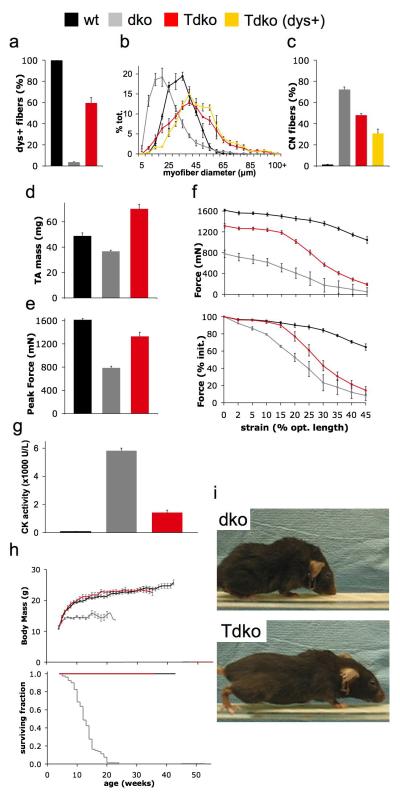Figure 2.
Systemic rAAV6-microdystrophin administration improves limb muscle function and extends the lifespan of dystrophic mice. (a) Dystrophin expression was restored in the majority of the myofibers comprising the Tibialis anterior muscles of mice examined 18 weeks after treatment (red), compared with the muscles of untreated dystrophic (grey) and wildtype (black) mice. (b) Dystrophin-positive myofibers in the muscles of treated mice (yellow) tended to be larger in diameter, (c) and less frequently centrally-nucleated than cells in the muscles of untreated mice. (d) Treatment was associated with an increased TA muscle mass, (e) and peak isometric force-producing capacity compared with untreated muscles (though unchanged specific force; wt, 240 ± 11, dko, 149 ± 5, Tdko, 145 ± 6 kN/m2). (f) Contractile performance expressed in terms of absolute force (upper) and performance relative to initial output (lower) demonstrates that the muscles of treated mice exhibit improved force output and resistance to contraction-induced injury when subjected to consecutive eccentric contractions of progressively increasing strain (identified as % beyond optimal muscle length). (g) Creatine kinase activity as measured in serum is markedly reduced in treated mice compared with untreated mice, yet remains moderately elevated compared with non-dystrophic animals. (h) Body mass (upper panel) in treated mice is increased compared with untreated animals, and comparable with the mass of wildtype mice. In cohorts monitored for lifespan (lower panel), treated mice (n = 8) live significantly longer than untreated mice (n = 70). (i) Untreated mice typically exhibit significant muscle wasting and kyphotic posture by 16 weeks of age, while treated mice retain considerably greater muscularity.

